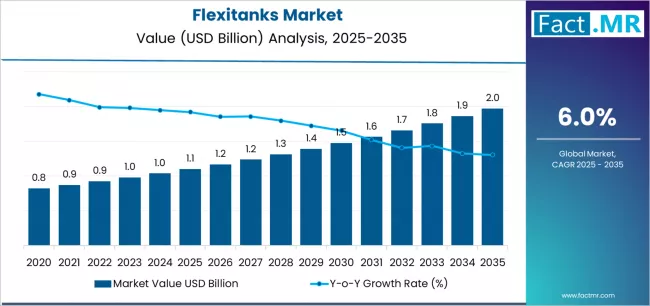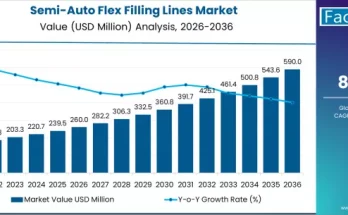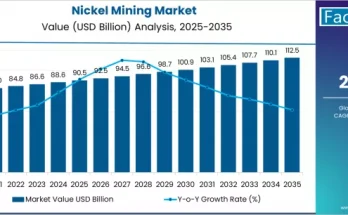The global flexitanks market is on a strong upward trajectory as industries increasingly transition toward cost-effective, safe, and eco-friendly bulk liquid transportation. According to a recent report by Fact.MR, the market’s journey from USD 1.1 billion in 2025 to USD 2.0 billion by 2035 represents substantial growth. The market will rise at a CAGR of 6.0%, demonstrating the accelerating adoption of flexible bulk liquid containers and efficient cargo handling solutions across food-grade transportation, chemical logistics, and specialty shipping sectors.
Flexitanks—large, multilayered containers fitted inside standard shipping containers—have transformed the bulk liquid transport industry by providing a lightweight, reusable, and contamination-free alternative to drums and IBCs. As sustainability, cost savings, and operational efficiency become key logistics priorities, flexitanks are redefining the movement of non-hazardous liquids worldwide.
Strategic Market Drivers
Booming Global Trade in Edible Liquids and Beverages
The food and beverage industry continues to be the largest consumer of flexitanks. Growing exports of edible oils, fruit concentrates, and wine are driving demand for hygienic and leak-proof solutions. Flexitanks offer 30% more payload capacity compared to drums, reducing per-unit transportation costs and minimizing carbon emissions. This has made them a preferred choice among exporters in Asia-Pacific, Europe, and Latin America.
Expanding Chemical and Industrial Liquid Transportation
The chemical industry’s move toward non-hazardous and semi-hazardous liquid logistics is accelerating flexitank adoption. Manufacturers of lubricants, surfactants, and liquid fertilizers are shifting from traditional ISO tanks to flexitanks for smaller, flexible volumes that reduce cleaning and repositioning costs. Advanced multilayer barrier films now enable safe transport of temperature-sensitive and reactive liquids across long distances.
Sustainability and Cost Efficiency at the Core
Flexitanks are contributing to sustainability goals by significantly reducing packaging waste and energy usage. Each flexitank eliminates the need for thousands of single-use drums, lowering the carbon footprint of international logistics. Additionally, innovations in biodegradable liners and recyclable polymer composites are enhancing their environmental profile, making them central to circular economy initiatives in packaging and shipping.
Browse Full Report: https://www.factmr.com/report/flexitanks-market
Regional Growth Highlights
East Asia: The Global Manufacturing and Export Hub
East Asia dominates the flexitanks market, driven by strong export demand from China, Japan, and South Korea. The region’s massive production of edible oils, industrial chemicals, and beverages supports robust logistics infrastructure and growing adoption of flexitank systems. China remains a key production center, with expanding local manufacturing capacities and partnerships with European logistics providers.
Europe: Innovation and Sustainability Integration
Europe is witnessing consistent market expansion, spurred by the EU’s stringent sustainability standards and emphasis on reducing maritime carbon emissions. Countries such as Germany, the Netherlands, and Spain are major adopters, leveraging flexitanks for both food-grade and specialty liquid transport. The growing popularity of returnable flexitank systems is setting new benchmarks for cost and waste reduction.
North America: Advanced Logistics and Supply Chain Efficiency
The U.S. and Canada are investing in next-generation bulk transport solutions to streamline chemical and beverage logistics. Flexitanks are gaining traction as logistics providers prioritize operational flexibility and last-mile efficiency. The region’s adoption is also fueled by the expanding wine and edible oil export sectors, coupled with integration of IoT-based tracking for liquid cargo monitoring.
Emerging Economies: Rising Trade and Infrastructure Growth
Markets in South Asia, the Middle East, and Latin America are experiencing rapid growth due to expanding trade routes, increasing agricultural exports, and government-driven logistics modernization programs. India and Brazil are particularly notable for their growing use of flexitanks in palm oil, wine, and non-hazardous chemical exports.
Market Segmentation Insights
By Product Type
- Single-Trip Flexitanks: Most widely used for one-way bulk liquid export.
- Multi-Trip Flexitanks: Gaining traction for sustainable and returnable logistics.
By Application
- Food-Grade Liquids: Edible oils, juices, and beverages.
- Industrial Liquids: Lubricants, detergents, and paints.
- Chemical Liquids: Non-hazardous chemicals and fertilizers.
Challenges and Considerations
- Regulatory Compliance: Transport regulations for food-grade and chemical liquids differ by region, posing logistical complexities.
- Material Quality Assurance: Maintaining consistent liner performance in high-temperature and long-haul conditions.
- Competition from ISO Tanks and Drums: Certain commodities still favor rigid bulk containers for multi-trip reliability.
- Waste Management: Ensuring post-use collection and recycling remains a sustainability focus.
Key Players in the Flexitanks Market
- SIA Flexitanks
- Hillebrand Gori
- Braid Logistics
- Qingdao LAF
- Environmental Packaging Technologies
- Trans Ocean Bulk Logistics
- Trust Flexitanks
- Anthente
- Rishi FIBC
- DHL Global Forwarding
These companies are investing in advanced liner materials, digital monitoring technologies, and region-specific service networks to meet the evolving needs of global shippers. Partnerships with major beverage, chemical, and agricultural exporters are further expanding the global reach of flexitank solutions.
Future Outlook: Toward Smarter, Sustainable Bulk Liquid Transport
As global trade expands and sustainability imperatives reshape logistics, flexitanks are set to become an indispensable component of modern supply chains. The next decade will witness greater integration of smart tracking systems, reusable liners, and eco-efficient materials, enabling real-time visibility and reduced environmental impact.
With innovation, cost optimization, and green logistics at its core, the flexitanks market is poised to deliver transformative value to industries worldwide—enhancing operational efficiency, reducing waste, and redefining the standards of bulk liquid transportation.



